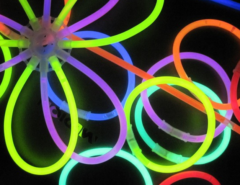April showers bring May flowers, but some of those flowers and plants can be poisonous. There are many different types of poisonous plants, and it isn’t always easy to tell whether a plant is poisonous or harmless. Below, we’ll take a look at the plants that specialists at the Maryland Poison Center received the most calls about last year.
Non-Toxic
Despite many myths, the following plants are non-toxic and will not cause any harm if touched or accidentally eaten:
- Wild strawberry
- Dandelion
- Mulberry
- Poinsettia
Toxic- Stomach Upset
The following plants are known to cause an upset stomach when consumed.
- Holly Berries – Only the berries of the holly plant are poisonous, not the leaves or twigs. Symptoms like vomiting, diarrhea, dehydration, and drowsiness are common when several berries are swallowed.
- Pokeberry – Also known as “ink berries,” pokeberries are not likely to cause any symptoms if you only eat a few. But, if you eat too many, symptoms such as vomiting and soapy diarrhea can occur. These berries turn the mouth purple when eaten, so if a child comes home with a purple-dyed mouth, there’s a chance they ate pokeberries, and should be monitored for symptoms.
- Hyacinth – Hyacinth flowers will not cause any problems if eaten in a small amount. But, if the stem, bulb, or leaves are eaten, nausea, vomiting, and diarrhea are likely. The bulb is the most toxic part of the hyacinth, followed by the stems, leaves, and then the flowers.
- Daffodil – Children are often attracted to the bright colored flowers of daffodils. Tasting a daffodil won’t cause any problems, but swallowing more than a few flowers can cause nausea, vomiting, and diarrhea. The bulb that grows underground can also be mistaken for an onion, but it doesn’t have an onion odor or cause your eyes to tear. And, eating the bulb will cause mouth and stomach irritation. Drinking the water that cut daffodils are in will also cause symptoms.
Toxic- Contain Cyanide
Swallowing the seed, pit, or kernel of the following fruits whole will not cause harm, but chewing or crushing them will. Eating a few will not cause any problems, but large amounts will cause symptoms.
- Cherry
- Apple
- Apricot – Apricot pits actually contain a kernel inside. These kernels look like almonds and can be bought in bags. Pay attention to the directions to learn how many can be eaten without causing harm.
- Other Stone Fruits – These fruits include plums, peaches, mangoes, and nectarines.
Toxic- Oxalate
When viewed under a microscope, oxalates look like little silver glass shards, long and skinny. They can’t be seen by the naked eye. If eaten, they can cause mouth irritation (feels like pins and needles stuck in your gums and on your tongue), severe swelling, and pain. Many common indoor houseplants contain oxalate crystals. If children or pets are home, these plants should be kept out of reach. Eating even one leaf could cause symptoms. If leaves fall to the floor, they need to be picked up and thrown away immediately. These plants are especially dangerous for cats.
- Peace lily
- Dieffenbachia
- Calla lily
- Philodendron
- Pothos
Toxic- Skin Irritation
The reaction to these plants differs from person to person. A majority of reactions occur if the sap or oils from the plant is left on the skin. If these plants touch your skin, rinse with water for 10 minutes, then gently wash the area with soap and water.
- Poison Ivy, Oak, and Sumac – The reaction to these plants is an allergic reaction; people react differently according to their sensitivity.
- Tulip – Handling a tulip won’t cause a problem, but over-handling tulip bulbs causes skin irritation. The nickname for this reaction is “tulip fingers.”
Toxic- Heart Effects
The following plants not only cause stomach upset, but also slow down your heart rate.
- Oleander
- Lily of the valley
- Azalea
- Milk weed
Toxic- Hallucinogenic
The following plant is known to cause severe reactions when consumed even in small amounts:
- Jimson Weed– Consuming jimson weed seeds in any form causes hallucinations, makes your skin feel hot and dry, and can lead to seizures, hyperthermia (high fever), rapid heartbeat, and kidney damage.
Mushrooms
Many edible mushrooms have toxic look-a-likes. The only way to identify a wild mushroom is through chemical testing. It is impossible for young children to tell them apart. Children should be taught to not touch or eat any mushrooms that don’t come from the grocery store. In general, mushroom foraging should only be done by the very experienced. Many people around the world die each year from mushroom poisoning. If a mushroom is ingested, call the poison center right away; do not wait for symptoms to call.
A poisonous plants list is available to download on our website. If a plant is on this list, it doesn’t mean it’s deadly — it might cause minor mouth irritation or a rash on the skin. If a plant is not on the list at all, it can’t be assumed to be poisonous or non-poisonous, as this list is not all-inclusive.
Remember, if you’re unsure about whether a plant is toxic, you can always call our experts at 1-800-222-1222.
If any plant is eaten, remove any remaining plant material from the person’s mouth. Rinse the mouth with water and call the Maryland Poison Center immediately for more instructions. Do not wait for symptoms to call. Also, do not make the person vomit. Calling the poison center is free and confidential; our poison experts are here to help 24/7/365.





Leave a Reply